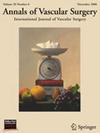Sarcopenia Influences Clinical Outcome in Hospitalized Patients with Peripheral Artery Disease Aged 75 Years and Older
IF 1.4
4区 医学
Q3 PERIPHERAL VASCULAR DISEASE
引用次数: 0
Abstract
Background
Sarcopenia represents a relevant comorbidity in patients with peripheral artery disease (PAD). However, only few studies exist assessing the clinical burden of sarcopenia in PAD.
Methods
All hospitalizations of patients aged ≥75 years who were admitted due to PAD within 2005–2020 in Germany were included in the study and stratified for sarcopenia. Temporal trends and the impact of sarcopenia on treatment procedures as well as adverse in-hospital events were investigated.
Results
Overall, 1,166,848 hospitalization cases of patients admitted due to PAD (median age 81.0 [78.0–85.0] years; 49.5% female sex) were included, of which 2,109 (0.2%) were coded with sarcopenia. Prevalence of sarcopenia in these patients increased during the observational period from 0.05% in 2005 to 0.34% in 2020 (β 2.61 [95%CI 2.42–2.80], P < 0.001). Sarcopenic PAD patients were more often female (52.1% vs. 49.5%, P = 0.015), obese (6.6% vs. 5.5%, P = 0.021), and revealed higher prevalences of comorbidities (Charlson comorbidity index, 7.00 [6.00–9.00] vs. 6.00 [5.00–7.00], P < 0.001). Sarcopenia was associated with reduced usage of reperfusion treatments (endovascular intervention: odds ratio (OR) 0.409 [95%CI 0.358–0.466], P < 0.001; surgical revascularization: OR 0.705 [95%CI 0.617–0.805], P < 0.001) but higher conduction of amputation (OR 1.365 [95%CI 1.231–1.514], P < 0.001) and higher rates of major adverse cardiovascular and cerebrovascular events (MACCE) (OR 1.313 [95%CI 1.141–1.512], P < 0.001) and in-hospital death (OR 1.229 [95%CI 1.052–1.436], P = 0.009).
Conclusions
Sarcopenia is an under-recognized condition in PAD patients of high clinical relevance causing a crucial disease burden. Awareness of the ailment needs to be increased in daily clinical practice to identify sarcopenia and improve the clinical outcome of this vulnerable patient group.
肌肉疏松症影响 75 岁及以上外周动脉疾病住院患者的临床预后。
目的:肌肉疏松症是外周动脉疾病(PAD)患者的一种相关合并症。然而,只有少数研究对 PAD 中肌肉疏松症的临床负担进行了评估:研究纳入了 2005-2020 年间德国所有因 PAD 住院的年龄≥75 岁的患者,并根据肌肉疏松症进行了分层。研究调查了时间趋势以及肌肉疏松症对治疗程序和院内不良事件的影响:研究共纳入了 1,166,848 例因 PAD 住院的患者(中位年龄为 81.0 [78.0-85.0] 岁;49.5% 为女性),其中 2109 例(0.2%)被编码为肌肉疏松症。在观察期内,这些患者的肌肉疏松症患病率从 2005 年的 0.05% 增加到 2020 年的 0.34%(β 2.61 [95%CI 2.42 至 2.80],PC 结论:在 PAD 患者中,"肌少症 "是一种未得到充分认识的疾病,其临床相关性很高,造成了严重的疾病负担。在日常临床实践中,需要提高对这一疾病的认识,以识别肌少症并改善这一弱势患者群体的临床预后。
本文章由计算机程序翻译,如有差异,请以英文原文为准。
求助全文
约1分钟内获得全文
求助全文
来源期刊
CiteScore
3.00
自引率
13.30%
发文量
603
审稿时长
50 days
期刊介绍:
Annals of Vascular Surgery, published eight times a year, invites original manuscripts reporting clinical and experimental work in vascular surgery for peer review. Articles may be submitted for the following sections of the journal:
Clinical Research (reports of clinical series, new drug or medical device trials)
Basic Science Research (new investigations, experimental work)
Case Reports (reports on a limited series of patients)
General Reviews (scholarly review of the existing literature on a relevant topic)
Developments in Endovascular and Endoscopic Surgery
Selected Techniques (technical maneuvers)
Historical Notes (interesting vignettes from the early days of vascular surgery)
Editorials/Correspondence

 求助内容:
求助内容: 应助结果提醒方式:
应助结果提醒方式:


